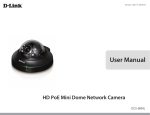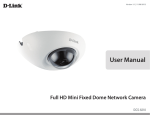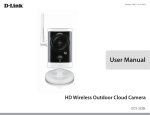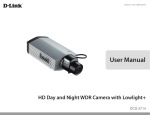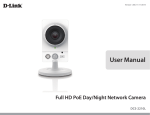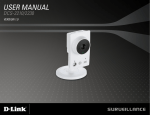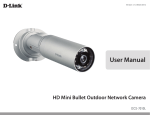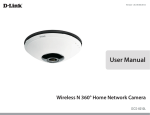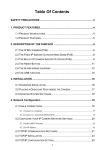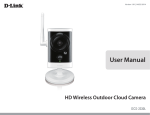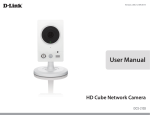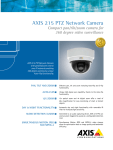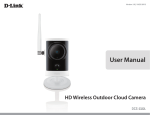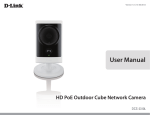Download User Manual - D-Link
Transcript
Version 1.00 | 11/26/2013 User Manual HD PoE/Wireless Mini Dome Network Camera DCS-6004L/DCS-6005L Preface D-Link reserves the right to revise this publication and to make changes in the content hereof without obligation to notify any person or organization of such revisions or changes. Information in this document may become obsolete as our services and websites develop and change. Please refer to the www.mydlink.com website for the most current information. Manual Revisions Revision Date 1.0 October 25, 2013 Description DCS-6004L/DCS-6005L Revision A1 with firmware version 1.00 Trademarks D-Link and the D-Link logo are trademarks or registered trademarks of D-Link Corporation or its subsidiaries in the United States or other countries. All other company or product names mentioned herein are trademarks or registered trademarks of their respective companies. Copyright © 2013 D-Link Corporation. All rights reserved. This publication may not be reproduced, in whole or in part, without prior expressed written permission from D-Link Corporation. D-Link DCS-6004L/DCS-6005L User Manual 2 Table of Contents Package Contents.................................................................. 4 Introduction............................................................................. 5 System Requirements.......................................................... 5 Features..................................................................................... 6 Hardware Overview.............................................................. 7 Front....................................................................................... 7 Installation....................................................................................... 8 Wireless Installation Considerations (DCS-6005L Only)........................................................................................... 8 Camera Installation Wizard................................................ 9 Windows Users....................................................................... 9 Mac Users...............................................................................10 Hardware Installation.........................................................11 Mounting the Camera........................................................12 Adjusting the Viewing Angle...........................................13 mydlink............................................................................................14 Configuration................................................................................15 Using the Configuration Interface.................................15 Live Video...............................................................................16 Setup........................................................................................17 Setup Wizard.....................................................................17 Network Setup..................................................................23 Wireless Setup .................................................................27 Dynamic DNS....................................................................28 Image Setup......................................................................29 D-Link DCS-6004L/DCS-6005L User Manual Audio and Video...............................................................31 Preset....................................................................................33 Motion Detection............................................................35 Time and Date...................................................................37 Event Setup........................................................................38 SD Card................................................................................46 ICR.........................................................................................47 HTTPS...................................................................................48 Access List...........................................................................49 Maintenance..........................................................................50 Device Management......................................................50 System.................................................................................52 Firmware Upgrade...........................................................53 Status.......................................................................................54 Device Info.........................................................................54 Logs......................................................................................55 Help......................................................................................56 Technical Specifications............................................................57 3 Section 1: Product Overview Product Overview Package Contents DCS-6004L/DCS-6005L HD PoE/Wireless Mini Dome Network Camera CAT5 Ethernet Cable Power Adapter Camera Accessories (Audio extension cable, female Ethernet connector, and mounting alignment guide) CD-ROM with User Manual and Software Quick Installation Guide If any of the above items are missing, please contact your reseller. Note: Using a power supply with a different voltage than the one included with your product will cause damage and void the warranty for this product. D-Link DCS-6004L/DCS-6005L User Manual 4 Section 1: Product Overview Introduction Congratulations on your purchase of the DCS-6004L/DCS-6005L HD PoE/Wireless Mini Dome Network Camera. The DCS-6004L/DCS-6005L is a versatile and unique solution for your small office or home. Unlike a standard webcam, the DCS-6004L/DCS-6005L is a complete system with a built-in CPU and web server that transmits high quality video images for security and surveillance. The DCS-6004L/DCS-6005L can be accessed remotely, and controlled from any PC/Notebook over your local network or through the Internet via a web browser. System Requirements • • • • • • Computer with Microsoft Windows® 8/7/Vista/XP, or Mac with OS X 10.6 or higher PC with 1.3GHz or above; at least 128MB RAM Internet Explorer 7, Firefox 12, Safari 4, or Chrome 20 or higher version with Java installed and enabled Existing 10/100 Ethernet-based network or 802.11n wireless network A MicroSD memory card (optional) is required for recording to onboard storage. SDHC Class 6 or above is recommended. Broadband Internet connection D-Link DCS-6004L/DCS-6005L User Manual 5 Section 1: Product Overview Features Simple to Use The DCS-6004L/DCS-6005L is a stand-alone system with a built-in CPU, requiring no special hardware or software. The DCS-6004L/DCS-6005L supports both ActiveX mode for Internet Explorer and Java mode for other browsers such as Chrome®, Firefox®, and Safari®. Supports a Variety of Platforms Supporting TCP/IP networking, HTTP, and other Internet related protocols. The DCS-6004L/DCS-6005L can also be integrated easily into other network applications because of its standards-based features. 802.11n Wireless or Ethernet/Fast Ethernet Support The DCS-6004L/DCS-6005L offers Power over Ethernet/Fast Ethernet connectivity or wireless 802.11n connectivity, making the DCS-6004L/DCS-6005L easy to integrate into your existing network environment. The DCS-6004L/DCS-6005L works with 10Mbps Ethernet networks or 100Mbps Fast Ethernet networks for traditional wired environments, and works wirelessly with 802.11n routers and access points for added flexibility. The Site Survey feature also allows you to view and connect to any available wireless networks. Web Configuration Using a standard Web browser, administrators can configure and manage the Network Camera directly from its own Web page via Intranet or Internet. This means you can access your DCS-6004L/DCS-6005L anytime, anywhere in the world. Broad Range of Applications With today’s high-speed Internet services, the Network Camera can provide the ideal solution for delivering live video images over the Intranet and Internet for remote monitoring. The Network Camera allows remote access using a Web browser for live image viewing, and allows the administrator to manage and control the Network Camera anytime, anywhere in the world. Many applications exist, including industrial and public monitoring of homes, offices, banks, hospitals, child-care centers, and amusement parks. Remote Monitoring Utility The D-ViewCam application adds enhanced features and functionality for the Network Camera and allows administrators to configure and access the Network Camera from a remote site via Intranet or Internet. Other features include image monitoring, recording images to a hard drive, viewing up to 32 cameras on one screen, and taking snapshots. IR LED for Day and Night Functionality The built-in infrared LEDs enables night time viewing of up to 16 feet (5 meters). D-Link DCS-6004L/DCS-6005L User Manual 6 Section 1: Product Overview Hardware Overview Front DCS-6004L 1 DCS-6005L 3 1 6 2 2 3 4 4 5 1 IR LED 2 microSD Card Slot 3 Camera Sensor 4 Status LED Used to illuminate the camera's field of view at night 1 IR LED Used to add storage for recording 2 microSD Card Slot HD-capable CMOS sensor 3 Status LED Indicates the camera's current status 4 WPS LED 5 WPS Button 6 Camera Sensor D-Link DCS-6004L/DCS-6005L User Manual Used to illuminate the camera's field of view at night Used to add storage for recording Indicates the camera's current status Indicates the current status of WPS Used to initialize WPS mode on the camera HD-capable CMOS sensor 7 Section 2: Installation Installation Wireless Installation Considerations (DCS-6005L Only) This D-Link device can connect to your wireless network from anywhere within the operating range of your wireless network. However, the number, thickness and location of walls, ceilings, or other objects that the wireless signals must pass through, may limit the range. Typical ranges vary depending on the types of materials and background RF (radio frequency) noise in your home or business. The key to maximizing wireless range is to follow these basic guidelines: 1. Minimize the number of walls and ceilings between your adapter and other network devices (such as your Network Camera) - each wall or ceiling can reduce your adapter’s range from 3-90 feet (1-30 meters). 2. Be aware of the direct line between network devices. A wall that is 1.5 feet thick (.5 meters), at a 45-degree angle appears to be almost 3 feet (1 meter) thick. At a 2-degree angle, it looks over 42 feet (14 meters) thick. Position your devices so that the signal will travel straight through a wall or ceiling (instead of at an angle) for better reception. 3. Building Materials make a difference. A solid metal door or aluminum studs may weaken the wireless signal. Try to position your access points, wireless routers, and other networking devices where the signal passes through drywall or open doorways. Materials and objects such as glass, steel, metal, walls with insulation, water (fish tanks), mirrors, file cabinets, brick, and concrete will degrade your wireless signal. 4. Keep your product at least 3-6 feet or 1-2 meters away from electrical devices or appliances that generate RF noise. 5. If you are using 2.4GHz cordless phones or other radio frequency sources (such as microwave ovens), your wireless connection may degrade dramatically or drop completely. Make sure your 2.4GHz phone base is as far away from your wireless devices as possible. The base transmits a signal even if the phone in not in use. D-Link DCS-6004L/DCS-6005L User Manual 8 Section 2: Installation Camera Installation Wizard Windows Users Insert the installation CD-ROM into your computer’s optical drive to start the Autorun program. Simply click Set up your Cloud Camera to go through the Setup Wizard, which will guide you step-by-step through the installation process from connecting your hardware to configuring your camera and registering it with your mydlink account. Note: If the Autorun program does not open, go to My Computer, browse to your CD drive, and double-click on the autorun.exe file. D-Link DCS-6004L/DCS-6005L User Manual 9 Section 2: Installation Mac Users Insert the installation CD-ROM into your computer’s CD drive. On the desktop, open your CD drive and double-click on the Setup_Wizard file. Within 20-30 seconds, the Setup Wizard will open, which will guide you step-by-step through the installation process from connecting your hardware to configuring your camera and registering it with your mydlink account. Note: mydlink Web portal requires JavaTM to function correctly. For more guidelines, please refer to mydlink FAQ pages at https://www.mydlink.com/faq/mydlink D-Link DCS-6004L/DCS-6005L User Manual 10 Section 2: Installation Hardware Installation Please refer to the steps below to assist you with hardware installation process for the camera. Remove the Camera Housing The camera housing needs to be separated from the camera base to expose the screw used to adjust the viewing angle. Remove the camera housing from the camera base by squeezing the housing release buttons on either side of the camera. Once the housing is released, lift it up and off the camera base to expose the Ethernet and power receptor. Connect the Ethernet Cable Connect the included Ethernet cable to the network cable connector located on the panel at the rear of the DCS-6004L/DCS-6005L and attach it to the network. Attach the External Power Supply Attach the external power supply to the DC Power receptor located on the rear panel of the DCS-6004L/DCS-6005L and connect it to your wall outlet or power strip. Reattach the Camera Housing Reattach the camera housing by lining up the housing so that the access port on the housing matches the access port on the camera base. Firmly push down until the camera housing snaps back onto the camera base. D-Link DCS-6004L/DCS-6005L User Manual 11 Section 2: Installation Mounting the Camera Please refer to the steps below to assist you with mounting the camera. We suggest that you configure the camera before mounting. 1.The camera needs to be separated from the mounting base to expose the holes in the mounting base. Remove the camera head from the mounting base by firmly holding the camera with the D-Link logo facing you and then sliding the mounting base towards you. 2.Place the mounting base alignment sticker where you want to position the camera. Depending on the material of the wall or ceiling, use proper tools to drill two holes where you placed the alignment sticker. If the wall is made out of concrete, drill the holes first, then insert the plastic anchors to support the screws. 3.Place the mounting base over the holes that are in the wall. Make sure to align the mounting base holes with the holes in the wall. Use the supplied screws to attach the mounting base to the surface of the wall. 1 2 34 Do not overtighten screws as this may crack the mount. 4.With the D-Link logo facing you, reattach the camera to the mounting plate by sliding the camera towards you until it locks into position. 4 5.Adjust the angle of the camera as desired, then tighten the collar on the camera stem to lock it in place. 5 D-Link DCS-6004L/DCS-6005L User Manual 12 Section 2: Installation Adjusting the Viewing Angle Please refer to the steps below to assist you with adjusting the viewing angle of the camera. We suggest that you configure the camera before mounting. 1.The camera housing needs to be separated from the camera base to expose the screw used to adjust the viewing angle. Remove the camera housing from the camera base by squeezing the housing release buttons on either side of the camera. 1 2.Lift the camera housing up off the camera base once the housing has been released. 2 3.Use a philips head screwdriver to loosen the retaining screw used to secure the viewing angle of the camera lens. 3 4.Manually adjust the viewing angle back and forth to your desired location. 4 5.Use a philips head screwdriver to tighten the retaining screw used to secure the viewing angle of the camera lens. 5 Do not overtighten screw as this may crack the mount. 6.Reattach the camera housing by lining up the housing so that the access port on the housing matches the access port on the camera base. Firmly push down until the camera housing snaps back onto the camera base. 6 7.Refer to "Mounting the Camera" on page 12 to learn how to correctly mount the camera to its permenant location. D-Link DCS-6004L/DCS-6005L User Manual 13 Section 3: mydlink mydlink After registering your DCS-6004L/DCS-6005L camera with a mydlink account in the Camera Installation Wizard. You will be able to remotely access your camera from the www.mydlink.com website. After signing in to your mydlink account, you will see a screen similar to the following: For more details on using your camera with mydlink, go to the Support section of the mydlink website and check the User Manual section for your product to find the latest instruction guide for your camera's mydlink features. D-Link DCS-6004L/DCS-6005L User Manual 14 Section 4: Configuration Configuration Using the Configuration Interface After completing the Camera Installation Wizard, you are ready to use your camera. The camera’s built-in Web configuration utility is designed to allow you to easily access and configure your DCS-6004L/DCS-6005L. At the end of the wizard, enter the IP address of your camera into a web browser, such as Mozilla Firefox. To log in, use the User name admin and the password you created in the Installation Wizard. If you did not create a password, the default password is blank. After entering your password, click OK. D-Link DCS-6004L/DCS-6005L User Manual 15 Section 4: Configuration Live Video This section shows your camera’s live video. You may select any of the available icons listed below to operate the camera. You may also select your language using the drop-down menu on the left side of the screen. You can zoom in and out on the live video image using your mouse. Right-click to zoom out or left-click to zoom in on the image. SD Status: This option displays the status of the SD card. If no SD card has been inserted, this screen will display the message "Card Invalid." Motion Trigger Indicator This indicator will change color when a trigger event occurs. Stop Note: The motion detection feature for your camera must be enabled. When a recording is in progress, this indicator will change color. This control pad can be used to electronically pan, tilt, and zoom (ePTZ) within the camera's predefined view area, if one has been defined. Starts the automatic panning function. The ROI will pan from back and forth within the FOV Stops automatic panning. Preset Path Starts the camera's motion along the predefined path. Recording Indicator Control Pad Auto Pan Video Profile 1 Video Profile 2 ePTZ Speed: You may select a value between 0 and 5. 0 is the slowest and 5 is the fastest. Taking a Snapshot Global View: This window indicates the total field of view (FOV) of the camera. The red box indicates the visible region of interest (ROI). Language: You may select the interface language using this menu. Go To: If any presets have been defined, selecting a preset from this list will (Preset List) display it. D-Link DCS-6004L/DCS-6005L User Manual 16 Section 4: Configuration Setup Setup Wizard To configure your Network Camera, click Internet Connection Setup Wizard. Alternatively, you may click Manual Internet Connection Setup to manually configure your Network Camera and skip to "Network Setup" on page 23. To quickly configure your Network Camera’s motion detection settings, click Motion Detection Setup Wizard. If you want to enter your settings without running the wizard, click Manual Motion Detection Setup and skip to"Motion Detection" on page 35. D-Link DCS-6004L/DCS-6005L User Manual 17 Section 4: Configuration Internet Connection Setup Wizard This wizard will guide you through a step-by-step process to configure your new D-Link Camera and connect the camera to the Internet. Click Next to continue. Note: Select DHCP if you are unsure of which settings to choose. Click Next to continue. D-Link DCS-6004L/DCS-6005L User Manual 18 Section 4: Configuration Select Static IP if your Internet Service Provider has provided you with connection settings, or if you wish to set a static address within your home network. Enter the correct configuration information and click Next to continue. If you are using PPPoE, select Enable PPPoE and enter your user name and password, otherwise click Next to continue. If you have a Dynamic DNS account and would like the camera to update your IP address automatically, select Enable DDNS and enter your host information. Click Next to continue. Enter a name for your camera and click Next to continue. D-Link DCS-6004L/DCS-6005L User Manual 19 Section 4: Configuration Configure the correct time to ensure that all events will be triggered as scheduled. Click Next to continue. If you have selected DHCP, you will see a summary of your settings, including the camera's IP address. Please write down all of this information as you will need it in order to access your camera. Click Apply to save your settings. D-Link DCS-6004L/DCS-6005L User Manual 20 Section 4: Configuration Motion Detection Setup Wizard This wizard will guide you through a step-by-step process to configure your camera's motion detection functions. Click Next to continue. Step 1 This step will allow you to enable or disable motion detection, specify the detection sensitivity, and adjust the camera’s ability to detect movement. You may specify whether the camera should capture a snapshot or a video clip when motion is detected. Please see the Motion Detection section on "Motion Detection" on page 35 for information about how to configure motion detection. Click Next to continue. Step 2 This step allows you to enable motion detection based on a customized schedule. Specify the day and hours. You may also choose to always record whenever motion is detected. Click Next to continue. D-Link DCS-6004L/DCS-6005L User Manual 21 Section 4: Configuration Step 3 This step allows you to specify how you will receive event notifications from your camera. You may choose not to receive notifications, or to receive notifications via e-mail or FTP. Please enter the relevant information for your e-mail or FTP account. Click Next to continue. Step 4 You have completed the Motion Detection Wizard. Please verify your settings and click Apply to save them. Please wait a few moments while the camera saves your settings and restarts. D-Link DCS-6004L/DCS-6005L User Manual 22 Section 4: Configuration Network Setup Use this section to configure the network connections for your camera. All relevant information must be entered accurately. After making any changes, click the Save Settings button to save your changes. DHCP: Select this connection if you have a DHCP server running on your network and would like your camera to obtain an IP address automatically. If you choose DHCP, you do not need to fill out the IP address settings. Static IP Address: You may obtain a static or fixed IP address and other network information from your network administrator for your camera. A static IP address may simplify access to your camera in the future. IP Address: Enter the fixed IP address in this field. Subnet Mask: This number is used to determine if the destination is in the same subnet. The default value is 255.255.255.0. Default Router: The gateway used to forward frames to destinations in a different subnet. Invalid gateway settings may cause the failure of transmissions to a different subnet. Primary DNS: The primary domain name server translates names to IP addresses. Secondary DNS: The secondary DNS acts as a backup to the primary DNS. D-Link DCS-6004L/DCS-6005L User Manual 23 Section 4: Configuration Enable UPnP Enabling this setting allows your camera to be Presentation: configured as a UPnP device on your network. Enable UPnP Enabling this setting allows the camera to add port Port Forwarding: forwarding entries into the router automatically on a UPnP capable network. Enable PPPoE: Enable this setting if your network uses PPPoE. User Name / Enter the username and password for your PPPoE Password: account. Re-enter your password in the Confirm Password field. You may obtain this information from your ISP. HTTP Port: The default port number is 80. Access Name for The default name is video#.mjpg, where # is the Stream 1~3: number of the stream. HTTPS Port: You may use a PC with a secure browser to connect to the HTTPS port of the camera. The default port number is 443. RTSP Port: The port number that you use for RTSP streaming to mobile devices, such as mobile phones or PDAs. The default port number is 554. You may specify the address of a particular stream. For instance, live1.sdp can be accessed at rtsp://x.x.x.x/video1. sdp where the x.x.x.x represents the ip address of your camera. Enable CoS: Enabling the Class of Service setting implements a best-effort policy without making any bandwidth reservations. D-Link DCS-6004L/DCS-6005L User Manual 24 Section 4: Configuration Enable QoS: Enabling QoS allows you to specify a traffic priority policy to ensure a consistent Quality of Service during busy periods. If the Network Camera is connected to a router that itself implements QoS, the router's settings will override the QoS settings of the camera. Enable IPV6: Enable the IPV6 setting to use the IPV6 protocol. Enabling the option allows you to manually set up the address, specify an optional IP address, specify an optional router and an optional primary DNS. D-Link DCS-6004L/DCS-6005L User Manual 25 Section 4: Configuration Enable Multicast The DCS-6004L/DCS-6005L allows you to multicast for stream each of the available streams via group address and specify the TTL value for each stream. Enter the port and TTL settings you wish to use if you do not want to use the defaults. D-Link DCS-6004L/DCS-6005L User Manual 26 Section 4: Configuration Wireless Setup (DCS-6005L Only) This section allows you to set up and configure the wireless settings on your camera. After making any changes, click the Save Settings button to save your changes. Site Survey: Click the Rescan button to scan for available wireless networks. After scanning, you can use the dropdown box to select an available wireless network. The related information (SSID, Wireless Mode, Channel, Authentication, Encryption) will be automatically filled in for you. SSID: Enter the SSID of the wireless access point you wish to use. Wireless Mode: Use the drop-down box to select the mode of the wireless network you wish to connect to. Infrastructure is normally used to connect to an access point or router. Ad-Hoc is usually used to connect directly to another computer. Channel: If you are using Ad Hoc mode, select the channel of the wireless network you wish to connect to, or select Auto. Authentication: Select the authentication you use on your wireless network - Open, Shared, WPA-PSK, or WPA2-PSK. Encryption: If you use WPA-PSK or WPA2-PSK authentication, you will need to specify whether your wireless network uses TKIP or AES encryption. If you use Open or Shared authentication, WEP encryption should be the setting. Key: If you use WEP, WPA-PSK, or WPA2-PSK authentication, enter the Key (also known as password) used for your wireless network. D-Link DCS-6004L/DCS-6005L User Manual 27 Section 4: Configuration Dynamic DNS DDNS (Dynamic Domain Name Server) will hold a DNS host name and synchronize the public IP address of the modem when it has been modified. A user name and password are required when using the DDNS service. After making any changes, click the Save Settings button to save your changes. Enable DDNS: Select this checkbox to enable the DDNS function. Server Address: Select your Dynamic DNS provider from the pull down menu or enter the server address manually. Host Name: Enter the host name of the DDNS server. User Name: Enter the user name or e-mail used to connect to your DDNS account. Password: Enter the password used to connect to your DDNS server account. Timeout: Enter the DNS timeout values you wish to use. Status: Indicates the connection status, which is automatically determined by the system. D-Link DCS-6004L/DCS-6005L User Manual 28 Section 4: Configuration Image Setup In this section, you may configure the video image settings for your camera. A preview of the image will be shown in Live Video. Enable Privacy The Privacy Mask setting allows you to specify up Mask: to 3 rectangular areas on the camera's image to be blocked/excluded from recordings and snapshots. You may click and drag the mouse cursor over the camera image to draw a mask area. Right clicking on the camera image brings up the following menu options: Disable All: Disables all mask areas Enable All: Enables all mask areas Reset All: Clears all mask areas. Anti Flicker: If the video flickers, try enabling this setting. Mirror: This will mirror the image horizontally. Flip: This will flip the image vertically. When turning Flip on, you may want to consider turning Mirror on as well. Power Line: Select the frequency used by your power lines to avoid interference or distortion. White Balance: Use the drop-down box to change white balance settings to help balance colors for different environments. You can choose from Auto, Outdoor, Indoor, Flourescent and Push Hold. D-Link DCS-6004L/DCS-6005L User Manual 29 Section 4: Configuration Exposure Mode: Changes the exposure mode. Use the drop-down box to set the camera for Auto, Indoor, Outdoor, Night Environments, or to Moving to capture moving objects. The Low Noise option will focus on creating a high-quality picture without noise. You can also create 3 different custom exposure modes. The Max Gain setting will allow you to control the maximum amount of gain to apply to brighten the picture. Denoise: This setting controls the amount of noise reduction that will be applied to the picture. Brightness: Adjust this setting to compensate for backlit subjects. Contrast: Adjust this setting to alter the color intensity/ strength. Saturation: This setting controls the amount of coloration, from grayscale to fully saturated. Sharpness: Specify a value from 0 to 8 to specify how much sharpening to apply to the image. Reset Default: Click this button to reset the image to factory default settings. D-Link DCS-6004L/DCS-6005L User Manual 30 Section 4: Configuration Audio and Video You may configure up to 2 video profiles with different settings for your camera. Hence, you may set up different profiles for your computer and mobile display. In addition, you may also configure the two-way audio settings for your camera. After making any changes, click the Save Settings button to save your changes. Mode: Set the video codec to be used to JPEG, MPEG-4, or H.264. Frame size / View Frame size determines the total capture resolution, window area: and View window area determines the Live Video viewing window size. If the Frame size is larger than the Live Video size, you can use the ePTZ controls to look around. 16:9 1280 x 800, 1280 x 720, 800 x 450, 640 x 360, 480 x 270, 320 x 176 4:3 1024 x 768, 800 x 600, 640 x 480, 480 x 360, 320 x 240 Note: If your View window area is the same as your Frame size, you will not be able to use the ePTZ function. Maximum frame A higher frame rate provides smoother motion for rate: videos, and requires more bandwidth. Lower frame rates will result in stuttering motion, and requires less bandwidth. D-Link DCS-6004L/DCS-6005L User Manual 31 Section 4: Configuration Video Quality: This limits the maximum frame rate, which can be combined with the "Fixed quality" option to optimize the bandwidth utilization and video quality. If fixed bandwidth utilization is desired regardless of the video quality, choose "Constant bit rate" and select the desired bandwidth. Constant bit The bps will affect the quality of the video recorded rate: by the camera. Higher bit rates result in higher video quality. Fixed quality: Select the image quality level for the camera to try to maintain. High quality levels will result in increased bit rates. Encoding: Select the audio encoding to use with the video stream. Audio in off: Selecting this checkbox will mute incoming audio (Mic). Audio in gain This setting controls the amount of gain applied to level: incoming audio to increase its volume. Audio out off: Selecting this checkbox will mute outgoing audio. Audio out This setting controls the amount of gain applied to volume level: outgoing audio to increase its volume. D-Link DCS-6004L/DCS-6005L User Manual 32 Section 4: Configuration Preset This screen allows you to set preset points for the ePTZ function of the camera, which allows you to look around the camera's viewable area by using a zoomed view. Presets allow you to quickly go to and view a specific part of the area your camera is covering, and you can create preset sequences, which will automatically change the camera's view between the different presets according to a defined order and timing you can set. Note: If your View window area is the same as your Frame size, you will not be able to use the ePTZ function. Video Profile: This selects which video profile to use. ePTZ Speed: You may select a value between 0 and 64. 0 is the slowest and 64 is the fastest. Arrow Buttons Use these buttons to move to a specific part of the and Home viewing area, which you can then set as a preset. Button: Click the Home button to return to the center of the viewing area. Input Preset Enter the name of the preset you want to create, Name: then click the Add button to make a new preset. If an existing preset has been selected from the Preset List, you can change its name by typing in a new name, then clicking the Rename button. Preset List: Click this drop-down box to see a list of all the presets that have been created. You can select one, then click the GoTo button to change the displayed camera view to the preset. Clicking the Remove button will delete the currently selected preset. D-Link DCS-6004L/DCS-6005L User Manual 33 Section 4: Configuration Preset Sequence: This section allows you to create a preset sequence, which automatically moves the camera's view between a set of preset views. Preset List: To add a preset to the sequence, select it from the drop-down box at the bottom of this window, set the Dwell time to determine how long the camera view will stay at that preset, then click the Add button. The preset name will appear in the list, followed by the dwell time to view that preset for. You can rearrange your presets in the sequence by selecting a preset in the sequence, then clicking the arrow buttons to move it higher or lower in the current sequence. Clicking the trash can button will remove the currently selected preset from the sequence. If you want to change the dwell time for a preset, select it from the list, enter a new dwell time, then click the Update button. D-Link DCS-6004L/DCS-6005L User Manual 34 Section 4: Configuration Motion Detection Enabling Video Motion will allow your camera to use the motion detection feature. You may draw a finite motion area that will be used for monitoring. After making any changes, click the Save Settings button to save your changes. Enable Video Select this box to enable the motion detection Motion: feature of your camera. Sensitivity: Specifies the measurable difference between two sequential images that would indicate motion. Please enter a value between 0 and 100. Percentage: Specifies the amount of motion in the window being monitored that is required to initiate an alert. If this is set to 100%, motion is detected within the whole window will trigger a snapshot. D-Link DCS-6004L/DCS-6005L User Manual 35 Section 4: Configuration Sound Detection Enabling Sound Detection will allow your camera to use the built-in microphone to trigger events with audio. If this option is selected, the trigger by option under SD recording, Video Clip, or Snapshot should also be selected. Enable Sound Select this box to enable the sound detection Detection: feature of your camera. Time: Specify the day and hours you would like sound detection monitoring to be active. You may also choose to always record whenever sound is detected. Detection Level: Specify the volume level that a sound must exceed in order to trigger the sound detection feature. The higher the number the more sensitive the camera will be to sound. Click Save Settings to save your changes. D-Link DCS-6004L/DCS-6005L User Manual 36 Section 4: Configuration Time and Date This section allows you to automatically or manually configure, update, and maintain the internal system clock for your camera. After making any changes, click the Save Settings button to save your changes. Time Zone: Select your time zone from the drop-down menu. Enable Daylight Select this to enable Daylight Saving Time. Saving: Synchronize Enable this feature to obtain time automatically with NTP Server: from an NTP server. NTP Server: Network Time Protocol (NTP) synchronizes the DCS-6004L/DCS-6005L with an Internet time server. Choose the one that is closest to your location. Set the Date and This option allows you to set the time and date Time Manually: manually. Copy Your This will synchronize the time information from Computer's Time your PC. Settings: D-Link DCS-6004L/DCS-6005L User Manual 37 Section 4: Configuration Event Setup In a typical application, when motion is detected, the DCS-6004L/DCS-6005L sends images to a FTP server or via e-mail as notifications. As shown in the illustration below, an event can be triggered by many sources, such as motion detection or external digital input devices. When an event is triggered, a specified action will be performed. You can configure the Network Camera to send snapshots or videos to your e-mail address or FTP site. Action Event Condition ex. Motion detection, Periodically, Digital input, System reboot Media (what to send) ex. Snapshot, Video Clips Server (where to send) ex. Email, FTP To start plotting an event, it is suggested to configure server and media columns first so that the Network Camera will know what action shall be performed when a trigger is activated. D-Link DCS-6004L/DCS-6005L User Manual 38 Section 4: Configuration The Event Setup page includes 4 different sections. • Server • Media • Event • Recording 1. To add a new item - "event, server or media," click Add. A screen will appear and allow you to update the fields accordingly. 2. To delete the selected item from the pull-down menu of event, server or media, click Delete. 3. Click on the item name in the drop-down menu for modifying. D-Link DCS-6004L/DCS-6005L User Manual 39 Section 4: Configuration Add Server You can configure up to 5 servers to save snapshots and/or video to. After making any changes, click the Save Settings button to save your changes. Server Name: Enter the unique name of your server. E-mail: Enter the configuration for the target e-mail server account. FTP: Enter the configuration for the target FTP server account. Network Specify a network storage device. Only one network Storage: storage device is supported. SD Card: Use the camera's onboard SD card storage. D-Link DCS-6004L/DCS-6005L User Manual 40 Section 4: Configuration Add Media There are three types of media, Snapshot, Video Clip, and System Log. After making any changes, click the Save Settings button to save your changes. Media Name: Enter a unique name for media type you want to create. Snapshot: Select this option to set the media type to snapshots. Source: Set the video profile to use as the media source. Refer to Audio and Video on "Audio and Video" on page 31 for more information on video profiles. Send pre-event Set the number of pre-event images to take. Preimage(s) [0~3]: event images are images taken before the main event snapshot is taken. Send post-event Set the number of post-event images to take. Postimage(s) [0~7]: event images are images taken after the main event snapshot is taken. You can set up to 7 postevent images to be taken. File Name Prefix: The prefix name will be added on the file name. Add date and Check it to add timing information as file name time suffix to file suffix. name: D-Link DCS-6004L/DCS-6005L User Manual 41 Section 4: Configuration Video Clip: Select this option to set the media type to video clips. Source: Set the video profile to use as the media source. Refer to "Audio and Video" on page 51 for more information on video profiles. Pre-event This sets how many seconds to record before the recording: main event video clip starts. You can record up to 3 seconds of pre-event video. Maximum Set the maximum length of video to record for duration: your video clips. Maximum file Set the maximum file size to record for your video size: clips. File Name Prefix: This is the prefix that will be added to the filename of saved video clips. System log: Select this option to set the media type to system logs. This will save the event to the camera system log, but will not record any snapshots or video. D-Link DCS-6004L/DCS-6005L User Manual 42 Section 4: Configuration Add Event Create and schedule up to 2 events with their own settings here. After making any changes, click the Save Settings button to save your changes. Event name: Enter a name for the event. Enable this Select this box to activate this event. event: Priority: Set the priority for this event. The event with higher priority will be executed first. Delay: Select the delay time before checking the next event. It is being used for both events of motion detection and digital input trigger. Trigger: Specify the input type that triggers the event. Video Motion Motion is detected during live video monitoring. Detection: Select the windows that need to be monitored. Periodic: The event is triggered in specified intervals. The trigger interval unit is in minutes. System Boot: Triggers an event when the system boots up. Time: Select Always or enter the time interval. D-Link DCS-6004L/DCS-6005L User Manual 43 Section 4: Configuration Add Recording Here you can configure and schedule the recording settings. After making any changes, click the Save Settings button to save your changes. Recording entry The unique name of the entry. name: Enable this Select this to enable the recording function. recording: Priority: Set the priority for this entry. The entry with a higher priority value will be executed first. Source: The source of the stream. Recording Scheduling the recording entry. schedule: Destination: Select the folder where the recording file will be stored. D-Link DCS-6004L/DCS-6005L User Manual 44 Section 4: Configuration Total cycling Please input a HDD volume between 1MB and 2TB recording size: for recording space. The recording data will replace the oldest record when the total recording size exceeds this value. For example, if each recording file is 6MB, and the total cyclical recording size is 600MB, then the camera will record 100 files in the specified location (folder) and will then delete the oldest file and create new file for cyclical recording. Please note that if there is not enough free HDD space, the recording will stop. Before you set up this option please make sure your HDD has enough space, and also do not save other files in the same folder as recording files. Size of each file If this is selected, files will be separated based on for recording: the file size you specify. Time of each file If this is selected, files will be separated based on for recording: the maximum length you specify. File Name Prefix: The prefix name will be added on the file name of the recording file(s). D-Link DCS-6004L/DCS-6005L User Manual 45 Section 4: Configuration SD Card Here you may browse and manage the recorded files which are stored on the SD card. If your SD card is not available or not formatted correctly, you camera will display the screen to the right. If you insert a new SD card, you may need to reboot the camera in order for it to recognize the newly inserted media. Format SD Card: Click this icon to automatically format the SD card and create "picture" & "video" folders. View Recorded If the picture files are stored on the SD card, click Picture: on the Picture link and choose the picture file you would like to view. Playback If video files are stored on the SD card, click on the Recorded Video: Video link and choose the video file you would like to view. Refresh: Reloads the file and folder information from the SD card. D-Link DCS-6004L/DCS-6005L User Manual 46 Section 4: Configuration ICR Here you can configure the ICR settings. An IR(Infrared) (Cut-Removable(ICR) filter can be disengaged for increased sensitivity in low-light environments. Automatic: The Day/Night mode is set automatically. Generally, the camera uses Day mode and switches to Night mode when needed. Day Mode: Day mode enables the IR Cut Filter. Night Mode: Night mode disables the IR Cut Filter. Schedule Mode: Set up the Day/Night mode using a schedule. The camera will enter Day mode at the starting time and return to Night mode at the ending time. D-Link DCS-6004L/DCS-6005L User Manual 47 Section 4: Configuration HTTPS This page allows you to install and activate an HTTPS certificate for secure access to your camera. After making any changes, click the Save Settings button to save your changes. Enable Enable the HTTPS service. HTTPS Secure Connection: Create Choose the way the certificate should be created. Certificate Three options are available: Method: • Create a self-signed certificate automatically • Create a self-signed certificate manually • Create a certificate request and install Certificate Displays the status of the certificate. You can click Information: on CSR Property or Certificate Property to view the HTTPS credentials being used. Remove: Click Remove to delete the certificate used. Note: The certificate cannot be removed while the HTTPS is still enabled. To remove the certificate, you must first uncheck Enable HTTPS secure connection. D-Link DCS-6004L/DCS-6005L User Manual 48 Section 4: Configuration Access List Here you can set access permissions for users to view your DCS-6004L/DCS-6005L. Allow list: The list of IP addresses that have access rights to the camera. Start IP address: The starting IP Address of the devices (such as a computer) that have permission to access the video of the camera. Click Add to save the changes made. Note: A total of seven lists can be configured for both columns. End IP address: The ending IP Address of the devices (such as a computer) that have permission to access the video of the camera. Delete allow list: Remove the customized setting from the Allow List. Deny list: The list of IP addresses that have no access rights to the camera. Delete deny list: Remove the customized setting from the Delete List. For example: When the range of the Allowed List is set from 1.1.1.0 to 192.255.255.255 and the range of the Denied List is set from 1.1.1.0 to 170.255.255.255. Only users with IPs located between 171.0.0.0 and 192.255.255.255 can access the Network Camera. D-Link DCS-6004L/DCS-6005L User Manual Alowed List Denied List 49 Section 4: Configuration Maintenance Device Management You may modify the name and administrator’s password of your camera, as well as add and manage the user accounts for accessing the camera. You may also use this section to create a unique name and configure the OSD settings for your camera. Admin Password Set a new password for the administrator’s account. Setting: Add User Add new user account. Account: User Name: The user name for the new account. Password: The password for the new account. User List: All the existing user accounts will be displayed here. You may delete accounts included in the list, but you may want to reserve at least one as a guest account. IP Camera Name: Create a unique name for your camera that will be added to the file name prefix when creating a snapshot or a video clip. Enable OSD: Select this option to enable the On-Screen Display feature for your camera. Label: Enter a label for the camera, which will be shown on the OSD when it is enabled. Show Time: Select this option to enable the time-stamp display on the video screen. D-Link DCS-6004L/DCS-6005L User Manual 50 Section 4: Configuration LED: You may specify whether or not to illuminate the status LED on the camera. D-Link DCS-6004L/DCS-6005L User Manual 51 Section 4: Configuration System In this section, you may backup, restore and reset the camera configuration, or reboot the camera. Save To Local Click on the Save Configuration button to save the Hard Drive: current configuration to your hard drive. Local From Local To load a saved configuration, click on the Browse Hard Drive: button to select a configuration file from your hard drive. Then, click the Load Configuration button to load the new configuration. Restore to Click this button to reset all settings to their factory Factory Default: defaults. If you select to reset your settings, you will need to set up your camera again. Reboot Device: Clicking the Reboot button will reboot your device. Schedule Select this option to schedule a time for the device Reboot: to reboot. After making any changes, click the Save button to save your changes. D-Link DCS-6004L/DCS-6005L User Manual 52 Section 4: Configuration Firmware Upgrade The camera's current firmware version will be displayed on this screen. You may visit the D-Link Support Website to check for the latest available firmware version. To upgrade the firmware on your DCS-6004L/DCS-6005L, please download and save the latest firmware version from the D-Link Support Page to your local hard drive. Locate the file on your local hard drive by clicking the Choose File button. Select the file and click the Upload button to start upgrading the firmware. Current Displays the detected firmware version. Firmware Version: Current Product Displays the date the firmware was released. Name: Current Product Displays the camera model name. Date: Choose File: Locate the file (upgraded firmware) on your hard drive. Upload: Uploads the new firmware to your camera. D-Link DCS-6004L/DCS-6005L User Manual 53 Section 4: Configuration Status Device Info This page displays detailed information about your device and its network connection. D-Link DCS-6004L/DCS-6005L User Manual 54 Section 4: Configuration Logs This page displays the log information of your camera. You may download the information by clicking Download. You may also click Clear to delete the saved log information. D-Link DCS-6004L/DCS-6005L User Manual 55 Section 4: Configuration Help This page provides helpful information regarding camera operation. D-Link DCS-6004L/DCS-6005L User Manual 56 Appendix A: Technical Specifications Technical Specifications Camera Network Camera Hardware Profile 1/4” 1 megapixel progressive CMOS sensor Minimum illumination: 0 lux (with IR LED on) Built-in microphone and audio out 10x digital zoom Fixed length: 2.8 mm Aperture: F1.8 Angle of view: (H) 75.2° (V) 48.2° (D) 89.3° Image Features Configurable image size, quality, frame rate, and bit rate Time stamp and text overlays Configurable privacy masks zone Configurable brightness, saturation, contrast, and sharpness Configurable motion detection windows Video Compression Simultaneous H.264/MPEG-4/MJPEG format compression H.264/MPEG-4 multicast streaming JPEG for still images Video Resolution 480x270, 16:9 -1280x800, 1280x720, 800x450,640x360, 320x176 up to 30 fps recording1 800x600, 640x480, 480x360, 320x240 up to 30 4:3 -1024x768, fps recording1 Audio Support G.711: 64kbps AAC: 64kbps External Device Interface 10/100 BASE-TX Fast Ethernet port 802.11n wireless (DCS-6005L only) MicroSD/SDHC card slot Network Protocols IPv6 IPv4 TCP/IP UDP ICMP DHCP client NTP client (D-Link) DNS client DDNS client (D-Link) SMTP client FTP client HTTP / HTTPS Samba client PPPoE UPnP port forwarding RTP / RTSP/ RTCP IP filtering QoS CoS Multicast IGMP ONVIF compliant Security Administrator and user group protection Password authentication HTTP and RTSP authentication D-Link DCS-6004L/DCS-6005L User Manual 2 57 Appendix A: Technical Specifications System System Management Requirements for Web Interface General Browser: Internet Explorer, Firefox, Chrome Event Management Motion/Sound detection Event notification and uploading of snapshots/video clips via e-mail or FTP Supports multiple SMTP and FTP servers Multiple event notifications Multiple recording methods for easy backup Remote Management Take snapshots/video clips and save to local hard drive via web browser Configuration interface accessible via web browser Mobile Support mydlink Lite/mydlink+ mobile app for iPhone, iPad, and Android mobile devices D-ViewCam™ System Requirements Operating System: Microsoft Windows 8/7/Vista/XP Web Browser: Internet Explorer 7 or higher Protocol: Standard TCP/IP D-ViewCam™ Software Functions Remote management/control of up to 32 cameras Viewing of up to 32 cameras on one screen Supports all management functions in web interface Scheduled motion triggered, or manual recording options Weight DCS-6004L: 130g (Without Stand) DCS-6005L: 135g (Without Stand) External Power Adaptor Input: 100 to 240 V AC, 50/60 Hz Output: 5 V DC, 1.2 A Power Consumption DCS-6004L: 3.5 watts max. DCS-6005L: 2.8 watts max. Temperature Operating: 0 to 40 °C (32 to 104 °F) Storage: -20 to 70 °C (-4 to 158 °F) Humidity Operating: 20% to 80% non-condensing Storage: 5% to 95% non-condensing Certifications CE CE LVD FCC Class B C-Tick Dimensions D-Link DCS-6004L/DCS-6005L User Manual 58 Appendix A: Technical Specifications Order Information Optional Accessories Part Number Description DCS-6004L HD PoE Mini Dome Network Camera DCS-6005L HD Wireless Mini Dome Network Camera Black Exterior Casing White Exterior Casing 1 2 Frame rates when streaming video may vary depending on network conditions and method used. A SDHC Class 6 card or above is recommended. Supports card capacities up to 32GB. D-Link DCS-6004L/DCS-6005L User Manual 59



























































